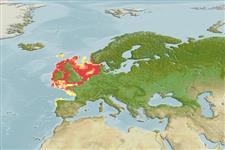Common names from other countries
Teleostei (teleosts) >
Perciformes/Uranoscopoidei (Sand dwellers) >
Ammodytidae (Sand lances)
Etymology: Gymnammodytes: Greek, gymnos = naked + Greek, ammos = sand + Greek, dytes = somebody that likes immersions or diving (Ref. 45335).
Environment: milieu / climate zone / depth range / distribution range
Ecology
Marine; demersal; depth range 5 - 20 m (Ref. 127989). Temperate; 62°N - 37°N, 11°W - 13°E
Northeast Atlantic: southern coast of Norway and the Shetlands to Spain, including all coasts of the British Isles and the North Sea, but not the Baltic.
Size / Weight / Age
Maturity: Lm ? range ? - ? cm
Max length : 30.0 cm SL male/unsexed; (Ref. 35388); common length : 15.0 cm TL male/unsexed; (Ref. 4645)
Short description
Morphology | Morphometrics
Dorsal
soft rays
(total): 53-56;
Anal
soft rays: 26 - 31. Palate without pointed teeth. Lateral line branched. Margins of dorsal and anal fins undulated. Scales restricted to the posterior third of the body (Ref. 35388).
Typically offshore over shell-gravel, also inshore where shell-gravel beaches occur. Feed on plankton. Summer batch spawner (Ref. 4674). By-catch in sand eel fisheries (Ref. 35388).
Life cycle and mating behavior
Maturity | Reproduction | Spawning | Eggs | Fecundity | Larvae
Reay, P.J., 1986. Ammodytidae. p. 945-950. In P.J.P. Whitehead, M.-L. Bauchot, J.-C. Hureau, J. Nielsen and E. Tortonese (eds.) Fishes of the north-eastern Atlantic and the Mediterranean. UNESCO, Paris. Vol. 2. (Ref. 4674)
IUCN Red List Status (Ref. 130435)
CITES (Ref. 128078)
Not Evaluated
Threat to humans
Harmless
Human uses
Fisheries: commercial; bait: usually
More information
ReferencesAquacultureAquaculture profileStrainsGeneticsElectrophoresesHeritabilityDiseasesProcessingMass conversion
Tools
Special reports
Download XML
Internet sources
Estimates based on models
Preferred temperature (Ref.
115969): 7.7 - 12.4, mean 10.4 (based on 502 cells).
Phylogenetic diversity index (Ref.
82804): PD
50 = 0.6250 [Uniqueness, from 0.5 = low to 2.0 = high].
Bayesian length-weight: a=0.00240 (0.00120 - 0.00478), b=3.10 (2.92 - 3.28), in cm Total Length, based on LWR estimates for this species & (Sub)family-body (Ref.
93245).
Trophic level (Ref.
69278): 2.7 ±0.30 se; based on food items.
Resilience (Ref.
120179): Medium, minimum population doubling time 1.4 - 4.4 years (Preliminary K or Fecundity.).
Fishing Vulnerability (Ref.
59153): Low to moderate vulnerability (27 of 100).
